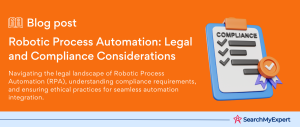Robotic Process Automation in Customer Service: Revolutionizing Interactions
The Pillars of Modern Customer Service
In the dynamic world of business, customer service stands as a beacon of brand identity and business success. It’s more than a support function; it’s an experience, a journey, a statement of value. Today’s customer service landscape is not just about answering calls or responding to emails. It’s about creating memorable experiences, fostering lasting relationships, and ensuring customer loyalty. This is where the game-changer enters: Robotic Process Automation (RPA).
Unveiling Robotic Process Automation (RPA)
Imagine a world where routine tasks are handled not by humans, but by intelligent machines. Welcome to the world of Robotic Process Automation. RPA is not just a buzzword; it’s a revolution. It involves deploying software robots that mimic human actions, executing repetitive and mundane tasks with precision and speed. These digital workers can log into applications, enter data, calculate, and even make decisions based on predefined rules.
The Convergence of RPA and Customer Service: A Synergy of Efficiency
When RPA meets customer service, it’s like a symphony of efficiency and effectiveness. This convergence is not just about reducing workload or cutting costs. It’s about transforming customer service into a powerhouse of satisfaction and engagement. RPA in customer service means faster response times, error-free processing, and 24/7 availability – a trifecta of benefits that can elevate customer experience to new heights.
Repetitive Tasks in Customer Service: Identifying Automation Opportunities
Pinpointing the Repetitive Realm
In the labyrinth of customer service operations, certain tasks repetitively demand attention. These are often rule-based, and mundane, yet crucial for the day-to-day functioning of the service domain. Identifying these areas is the first step towards revolutionizing customer service through automation.
Examples of Repetitive Tasks: The Usual Suspects
- Data Entry:
A quintessential example, where customer information needs to be inputted into databases or CRM systems. - Form Processing: Handling and processing customer forms, be it for registrations, feedback, or requests.
- Automated Emails: Sending out confirmation emails, newsletters, or response emails to common queries.
- Responding to FAQs: Addressing frequently asked questions, which often have standard responses.
The Manual Challenge: Time-Consumption and Error-Prone
When handled manually, these tasks can be akin to a tightrope walk over a valley of inefficiency. Time-consuming? Absolutely. The manual execution of these tasks devours hours that could otherwise be invested in more strategic functions. Error-prone? Indeed. Human fatigue and monotony can lead to errors, affecting the quality of service and potentially leading to customer dissatisfaction.
RPA Bots in Customer Service: The Automation Game-Changers
Deploying RPA Bots: The Shift Towards Efficiency
In the realm of customer service, the introduction of RPA bots signifies a pivotal shift from manual monotony to automated efficiency. These digital assistants are not just tools; they’re game-changers. They take over repetitive tasks, allowing human agents to focus on more complex, value-added interactions with customers.
Capabilities of RPA Bots: Beyond Mere Automation
- Mimicking Human Actions: RPA bots can navigate computer systems just like a humans, but faster and without errors.
- Data Extraction:
They possess the ability to extract relevant information from various types of documents, streamlining data processing. - Triggering Pre-defined Actions: Bots can automatically perform actions based on specific triggers or criteria, ensuring timely responses.
Real-world Examples: RPA Bots in Action
- Automating Email Responses: Bots can handle routine customer emails, sending out accurate responses instantaneously.
- Form Processing: Automatically processing customer forms for requests or feedback, enhancing processing speed and accuracy.
- Data Management:
Updating customer information in databases, ensuring data consistency and reliability.
By deploying RPA bots in customer service, companies can not only enhance efficiency but also improve the overall customer experience. It’s a strategic move towards a more responsive, agile, and customer-centric service model.
Benefits of RPA in Customer Service: A Paradigm Shift
Unleashing Efficiency and Productivity
The implementation of RPA in customer service ushers in an era of unprecedented efficiency. Tasks that once took hours, now take minutes or even seconds. This monumental leap in productivity means customer service teams can handle higher volumes of queries without compromising quality.
Quantifying Efficiency:
- Case Study:
A telecom company implemented RPA for handling service requests, resulting in a 40% increase in process efficiency. - Data Point:
On average, RPA can reduce the time taken for data entry and processing tasks by up to 70%.
Enhanced Accuracy and Reduced Errors
RPA bots are meticulously accurate. They follow programmed instructions without deviation, eliminating human errors. This precision ensures consistency in customer interactions and record-keeping.
The Numbers Speak:
- Statistical Insight:
Error reduction rates of up to 90% have been reported following the integration of RPA in customer service workflows.
Accelerated Response Times and Resolution Rates
With RPA, responses to customer queries are not just accurate but also swift. Automated processes ensure that customers receive prompt and reliable answers, leading to faster resolution of their concerns.
Real Results:
- Example:
An e-commerce company utilized RPA to automate its email responses, cutting down response time from hours to minutes.
24/7 Availability and Skyrocketing Customer Satisfaction
RPA bots don’t sleep, don’t take breaks, and don’t need vacations. They offer 24/7 customer service, ensuring that customers receive support whenever they need it, significantly boosting satisfaction levels.
Satisfaction Scores:
- Impact Assessment: After deploying RPA, businesses have observed up to a 50% increase in customer satisfaction ratings.
By leveraging RPA, customer service departments are not just changing the way they operate; they are redefining the customer experience. It’s a transformation that’s measurable, impactful, and absolutely game-changing.
Challenges and Considerations for RPA Implementation: Navigating the Maze
Acknowledging the Hurdles
Implementing RPA in customer service is not without its challenges. Recognizing and preparing for these obstacles is crucial for a smooth transition into an automated future.
Initial Investment Costs
- Reality Check:
Upfront costs for RPA include software purchase, infrastructure modification, and process reengineering. - Overcoming Strategy: Opt for phased implementation, starting small to prove ROI before scaling up.
Change Management and Employee Training
- Human Factor:
Employees may be resistant to change, fearing job loss or skill redundancy. - Mitigation Plan:
Foster a culture of digital transformation through continuous training and emphasizing the value-add of RPA in augmenting human roles.
Security and Data Privacy Concerns
- Cybersecurity Concerns: Integrating RPA involves handling sensitive customer data, raising
security questions. - Solution Pathway: Implement robust security protocols and regular audits to ensure data integrity and compliance with privacy regulations.
Identifying Suitable Tasks for Automation
- Selection Challenge: Not all tasks are suitable for automation; some require human judgment and empathy.
- Strategic Approach: Conduct thorough process mapping to identify repetitive, rule-based tasks ripe for RPA, while leaving complex decision-making to humans.
By navigating these challenges with strategic planning and a clear vision, businesses can ensure a successful RPA implementation, leading to a more efficient, accurate, and responsive customer service operation.
The Future of RPA in Customer Service: Charting the Course Ahead
Envisioning Tomorrow’s RPA Landscape
The trajectory of RPA in customer service is not just upward; it’s exponential. As we look to the future, we see a landscape reshaped by intelligent automation, where customer service transcends traditional boundaries.
Emerging Trends: Cognitive RPA and Beyond
- Cognitive RPA: The next evolution in RPA, blending AI and machine learning with traditional RPA, enabling bots to handle unstructured data and make complex decisions.
- Intelligent Automation:
This trend sees RPA evolving into a more holistic approach, integrating with other technologies like chatbots and virtual assistants to provide a more seamless customer experience.
The Ripple Effect: Impact on Customer Service and Workforce
- Customer Service Transformation: RPA will lead to more personalized and proactive customer service, with bots anticipating needs based on data analysis.
- Workforce Evolution:
The role of human agents will shift towards more strategic, creative tasks. RPA’s rise will also spur new job roles focused on managing and optimizing these intelligent systems.
The future of RPA in customer service is not just about technology; it’s about a paradigm shift in how we view customer interactions and the role of the workforce. It promises a more efficient, responsive, and personalized service landscape.
Embracing the RPA Revolution in Customer Service
Summing Up the Automation Journey
Our exploration of Robotic Process Automation in customer service has been a journey through a landscape of efficiency, accuracy, and innovation. From identifying the repetitive tasks ripe for automation to understanding the challenges and strategies for successful RPA implementation, we’ve seen how RPA is not just a tool, but a transformative force.
The Power of RPA: A Game Changer for Customer Service
RPA stands as a beacon of progress in the realm of customer service. By automating mundane tasks, RPA frees human agents to focus on complex, value-added interactions, enhancing the overall customer experience. The integration of cognitive RPA and intelligent automation heralds a future where customer service is more personalized, proactive, and impactful.
A Call to Action: Seize the RPA Opportunity
The potential of RPA in revolutionizing customer service is clear. It’s an opportunity to not just improve operations but to redefine them. Businesses looking to stay competitive and elevate their customer experience must consider integrating RPA into their customer service strategy. The time to act is now – to explore, to implement, and to lead in the age of automation.
Embrace the change, explore the possibilities, and be a part of the RPA revolution in customer service.
Conclusion
Robotic Process Automation (RPA) emerges as a transformative solution in the realm of customer service, offering a myriad of benefits. By automating repetitive, rule-based tasks, RPA enhances efficiency, accuracy, and responsiveness, leading to increased productivity and improved customer satisfaction. The integration of cognitive capabilities and intelligent automation points towards a future where customer service operations are not only efficient but also intuitively attuned to customer needs.
Businesses should view RPA not merely as a tool for cost-cutting but as a strategic asset that can significantly elevate the customer experience. As we look ahead, the role of RPA in customer service is poised to expand, bringing more sophisticated, personalized, and proactive interactions.
Now is the moment for businesses to explore and embrace RPA, to not only stay competitive but also to redefine the standards of customer service. The call to action is clear: delve into the possibilities of RPA and harness its potential to transform your customer service landscape.
Transform your enterprise with our Robotic Process Automation Services.
Further Reading
Table of Contents
Toggle






